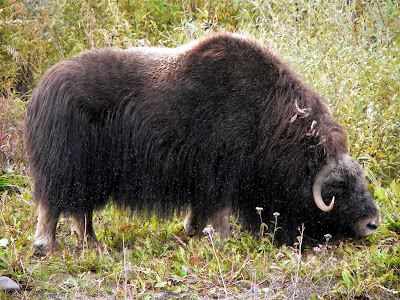The Brooks Range is Alaska's premier alpine wilderness. There is a sense of wide open spaces with much of the range north of the tree line. It is a place of extremes with long, cold, dark winters and -40F temperatures and lower for long periods of time. A place of very few people, mostly Athabascan and Eskimo, ground-hugging tundra plants and, at times, hundreds of thousands of migrating caribou.
We are entering the Brooks Range here and passing musk oxen, caribou and Dall sheep on the road is no big deal.
The short mounds of earth between the road and Sukakpak Mountain are palsas, formed by ice beneath the soil pushing the vegetative mat and soil upward.
This is the last spruce tree prior to crossing beyond the tree zone in the Arctic.
Steep, rocky slopes and glacier-carved valleys dominate this rugged landscape.
Looking down the Range from the top of Atigun Pass as we cross the Continental Divide. Rivers south of here flow into the Pacific Ocean or Bering Sea, while rivers to the north flow into the Arctic Ocean.
These two hardy bikers are riding from British Columbia to Prudhoe Bay and back. It is cold and windy. The road is rugged. There is no place to eat or sleep but out in the open. And not much help out there. George and Betty gave them some water, as all they had was from the streams.
Leaving the mountains behind, we cross the flat, coastal plain of the north slope, a land of stark, trackless beauty and undisturbed nature. This far north, the sun never sets between May 10 and August 2, and never rises between November 18 and January 23.
Only tough, ground-hugging plants can survive the frozen ground, frigid temperatures, icy winds, and weak sunlight.
Ponds or lakes called thermokarsts form when underground ice thaws, often after disturbances such as wildfire, earthquakes, climate change, or clearing ground for construction.
Arctic Ground Squirrel. To learn some real neat stuff about this guy, including how they survive when their body temperature drops below freezing, go to this site--
Musk oxen are a relic of the ice age. They live in open tundra. If predators threaten, they defend themselves by standing in a circle side-by-side, heads pointed out, in protective rings.
Note the many flies, gnats and mosquitoes, which are a constant problem for them.
This herd walked on the side of the road right past our truck.
This is the way camping should be. Notice the dirt on our rigs

























No comments:
Post a Comment